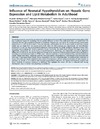Please use this identifier to cite or link to this item:
https://accedacris.ulpgc.es/jspui/handle/10553/21077
| Title: | Influence of neonatal hypothyroidism on hepatic gene expression and lipid metabolism in adulthood | Authors: | Santana Farré, Ruymán Mirecki-Garrido, Mercedes Bocos, Carlos Henríquez Hernández, Luis Alberto Kahlon, N. Herrera, Emilio Norstedt, G. Parini, P. Flores Morales, Amílcar Fernandez-Perez, Leandro |
UNESCO Clasification: | 3209 Farmacología | Keywords: | Hypothyroidism Hepatic gene expression Lipid metabolism |
Issue Date: | 2012 | Project: | Mecanismos Moleculares y Celulares de Señalización Intracelular en Respuesta A la Hormona de Crecimiento Humana: la Vía Jak (Janus Kinase) Stat (Signal Transducer And Activator Of Transcription) Co Estudio Funcional y Molecular de Las Proteínas Socs en Un Modelo de Resistencia Hepática A Insulina. |
Journal: | PLoS ONE | Abstract: | Thyroid hormones are required for normal growth and development in mammals. Congenital-neonatal hypothyroidism (CH) has a profound impact on physiology, but its specific influence in liver is less understood. Here, we studied how CH influences the liver gene expression program in adulthood. Pregnant rats were given the antithyroid drug methimazole (MMI) from GD12 until PND30 to induce CH in male offspring. Growth defects due to CH were evident as reductions in body weight and tail length from the second week of life. Once the MMI treatment was discontinued, the feed efficiency increased in CH, and this was accompanied by significant catch-up growth. On PND80, significant reductions in body mass, tail length, and circulating IGF-I levels remained in CH rats. Conversely, the mRNA levels of known GH target genes were significantly upregulated. The serum levels of thyroid hormones, cholesterol, and triglycerides showed no significant differences. In contrast, CH rats showed significant changes in the expression of hepatic genes involved in lipid metabolism, including an increased transcription of PPARa and a reduced expression of genes involved in fatty acid and cholesterol uptake, cellular sterol efflux, triglyceride assembly, bile acid synthesis, and lipogenesis. These changes were associated with a decrease of intrahepatic lipids. Finally, CH rats responded to the onset of hypothyroidism in adulthood with a reduction of serum fatty acids and hepatic cholesteryl esters and to T3 replacement with an enhanced activation of malic enzyme. In summary, we provide in vivo evidence that neonatal hypothyroidism influences the hepatic transcriptional program and tissue sensitivity to hormone treatment in adulthood. This highlights the critical role that a euthyroid state during development plays on normal liver physiology in adulthood. | URI: | https://accedacris.ulpgc.es/handle/10553/21077 | ISSN: | 1932-6203 | DOI: | 10.1371/journal.pone.0037386 | Source: | PLOS One [ISSN 1932-6203], v. 7(5), e37386 | Rights: | by-nc-nd |
| Appears in Collections: | Artículos |
SCOPUSTM
Citations
22
checked on Jun 8, 2025
WEB OF SCIENCETM
Citations
21
checked on Jun 8, 2025
Page view(s)
87
checked on May 5, 2024
Download(s)
167
checked on May 5, 2024
Google ScholarTM
Check
Altmetric
Share
Export metadata
Items in accedaCRIS are protected by copyright, with all rights reserved, unless otherwise indicated.
